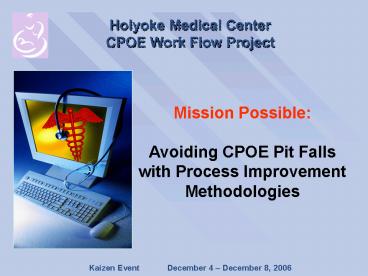Mission Possible: - PowerPoint PPT Presentation
1 / 41
Title: Mission Possible:
1
Mission Possible Avoiding CPOE Pit Falls with
Process Improvement Methodologies
2
Hospital Profile
- Located in Western Massachusetts
- 212 Bed Community Hospital
- 35,000 Emergency Room Visits
- Per Year
- Hospitalist program
3
Agenda
- Holyoke Medical Centers CPOE Objectives
- and Goals
- Introduction to Process Improvement
- Methodologies
- Physician Workflow Event
4
Inpatient Computerized Physician Order Entry
(CPOE)
Objective
To redesign the physician work flow process by
implementing evidence-based order sets and
decision support tools that will reduce errors,
improve efficiencies and communication by
utilizing Information Technology.
5
Inpatient Computerized Physician Order Entry
(CPOE)
Scope
- Laboratory, radiology, nursing, ancillary, and
medication - orders
- eMAR (Med Administration Record)
- Rules Alerts
- Medication Reconciliation
- Zynx Orders Sets Evidence-Based
- Single Sign On
6
Inpatient Computerized Physician Order Entry
(CPOE)
Goal 1
Improve organizational communication and quality
of information for clinical decisions.
Goal 2
Reduce adverse drug events and medication errors
by 75.
Improve accuracy and completeness of orders
reducing Pharmacy and other Ancillary departments
rework by 75.
Goal 3
Reduce unnecessary or redundant lab tests by 75.
Goal 4
7
The First Attempt at Process Improvement
8
(No Transcript)
9
Introduction to Lean Thinking
10
What is Lean Thinking?
Lean ? Mean
- or downsizing or outsourcing or working harder
- Rethink your entire operation
- Simply, lean means using less to do more
- Eliminate waste to optimize value
- Concept of Lean Management associated with
- the Toyota Production System
11
The Toyota Way
Best Quality Lowest Cost Shortest Lead
Time Best Safety Highest Morale
PDCA Learning Cycles (Continuous Learning Systems
for Every Employee)
John Shook 2005
12
Leadership and Communication at Toyota
- Leaders are teachers and mentors ask why 5
- times?
- All actions revolve around plan and
problem-solving - No problem is a problem
- Problems are opportunities to learn
- For the system to work, problems must be exposed
- and dealt with forthrightly
- No excuses vs. no blame everyone reacts to
- problem ask why not who
- Tremendous reliance on individual initiative
13
Communication Effectiveness in Hospitals
The Current State as demonstrated by the
following 3 examples
14
(No Transcript)
15
(No Transcript)
16
(No Transcript)
17
Traditional Culture vs. Lean Culture
Traditional Culture Lean Culture
Source A.P. Byrne, O.J. Fiume
18
Why Lean in Healthcare?
Healthcare is Like Base Jumping
- Hospitalizations 33.6 million/year
- Deaths due to medical error up to 100K/year
- Deaths due to hospital acquired infection up
- to 100K/year
Fixing Healthcare from the Inside, Today Steven
J. Spear January 2006
19
The Need The 8 Wastes
Unused Employee Creativity
Inventory
Defects
Waiting
Over Production
Motion
Material Movement
Extra Processing
Lack of Training
System Limitation
Current Roles Responsibilities
No Standardized Work
Office Layout
Performance Measures
Identifying Root Causes of Visible Waste
20
- Preparing for Our CPOE Workflow Event
- Observations
- Developing Event Goals
- Team Selection
21
(No Transcript)
22
(No Transcript)
23
(No Transcript)
24
(No Transcript)
25
Our Team
- 2 Certified Lean Facilitators
- 3 Physicians
- Medical Information Officer
- Hospitalist
- Private Physician
- Nursing
- Representation from all Ancillary Departments
- Meditech
- Total Participation 35 Team Members
26
Your Mission If You Choose To Accept
To identify work flow process and infrastructure
issues to completely understand inpatient
physician ordering and to help break down
barriers prior to implementation.
Planning Communicating Engaging Change
management Process improvement Overcoming
resistance Building trust Designing it
right Being flexible Being forthright Testing
Training Nurturing Rewarding
27
Agenda
28
MD Ordering Process Current State
29
Discharge Ordering Process Current State
30
Typical Problems Observed in Organization
Value From the perspective of the
customer Understanding Customer Requirements
Example Not meeting timing needs
Flow No Waiting No Rework Information
Available Many handoffs, Interrupts, Waiting for
decisions and approvals
Work Standardized Built in Quality Significant
Rework, Standards not being followed
(workarounds) or no standard
Manage, Improving and Learning Milestones and
Checkpoints, Learning Embedded Over processing,
no management corrective action, limited feedback
31
What is a Lean Value Stream?
?
?
Valuable
Flow
No waiting No rework Information available
from the perspective of the customer
?
?
?
Managing Improving and learning
Work
Standardized Built in quality
Milestones and checkpoints Learning embedded
32
Making the Work Flow
Step 1
Value Stream Chunks or Loops
Apply basic Lean concepts
Step 2
- Reduce handoffs by combining steps
- Eliminate waiting for decisions with a proceed
unless halted agreement - Maximize flow by managing interrupts
Step 3
Apply Lean tools
- Standard/balanced work reduce variation in
work - Visual workplace identify problems (defects,
backlog) - Built-in-quality eliminate rework
- Pull systems a method to control process flow
by replacing only what is consumed - Reduce handling, storage and paperwork
- Production based on consumption
33
MD Ordering Process Future State
34
Discharge Ordering Process Future State
35
Creating the Future State
36
Creating the Future State
37
Creating the Future State
38
Organizational Will
The introduction of a CPOE system requires a
shift in everyday practices of all members of a
health care team. Change is daunting for many
physicians, nurses and health administrators,
which is why a clear understanding of CPOE and
its benefits, possible drawbacks, and obstacles
is necessary. An institution must overcome these
barriers for a successful transition. Upperman
JS et al. The Introduction of Computerized
Physician Order Entry and Change
39
(No Transcript)
40
Questions?
HMC
41
- References
- Going Lean in Health Care, Innovations 2005,
Institute for Healthcare Improvement - Lessons from Toyota for Health Care?, John Shook,
January 2006. - Fixing Healthcare from Inside, Today, Steven J.
Spears, January 2006































